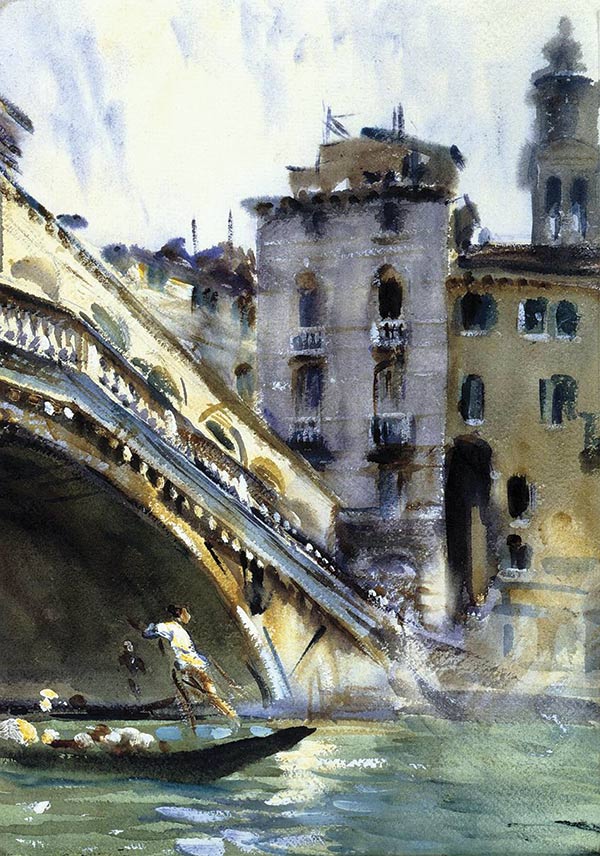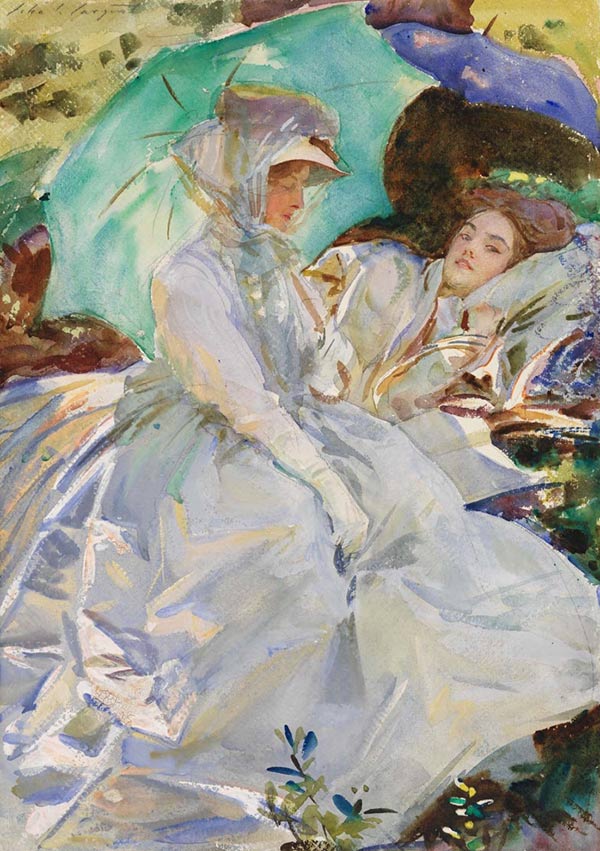John Singer Sargent (1856-1925) painted watercolors throughout his European childhood. Like his family, the dependents of the peripatetic Dr. Fitzwilliam Sargent, watercolors were portable and picturesque. Sargent continued to paint watercolors in the 1870s as a student in Paris and in the 1880s and 1890s when his oil portraits, applying Old Master grandeur to the gloss of new money, defined the ages Gilded and Edwardian. But only after 1900, when Sargent renounced the clientele and commissions of the society portrait, did watercolors become the preferred medium of his late style.
Sargent’s early watercolors shared the spare handling and tonal restraint of his Parisian oils of the 1870s. When in the 1880s his oil portraits acquired broken brushwork and a higher-keyed palette, his watercolors did too. They were private exercises or preparatory studies; after sending two watercolors of Venice to the Paris Salon of 1881, Sargent did not exhibit a watercolor until 1903. By then, however, his watercolors were no longer subordinate to his oils, and he was no longer subordinate to the studio.
Sargent: The Watercolours, now at the Dulwich Picture Gallery, London, is a glorious, light-filled memoir of the liberations that followed and how the last great portraitist of the 19th century became the first great watercolorist of the 20th. In Paris, Sargent had studied oil painting in the progressive atelier of Carolus-Duran, who taught painting au premier coup, applying strokes of paint “wet-on-wet.” If Sargent painted in oil with the speed of a watercolorist, he layered his watercolors with the eye of an oil painter.

‘The Rialto Bridge, Venice’ (ca. 1900-1904)
For The Rialto Bridge, Venice (ca. 1900-04), Sargent decides to turn his paper vertically, portrait-style, to emphasize the effects of light and movement. He sketches a few sweeps of pencil: the edges of the buildings in the background; the plunge of the bridge, less than half of which he will show us; and the body of a waterman who leans forward to push his sandolo barge under the bridge. Then Sargent dives in with the brush. In the left foreground, he notates the stone bridge in an ethereal shorthand of soft washes and shadows, pale green over mauve, with white paper standing for unshadowed stone. He washes the two narrow buildings that anchor the bridge to the Rialto in broad strokes of pale green and mauve too, but separates their colors carefully along the pencil guideline of their party wall.
Juggling brushes again—he liked to hold a handful, to save time—Sargent marks the balconies of the mauve building and the windowsills of the green building with grids of the whitest purple. Then he reunites his colors and composition by adding tiny vertical strips of deep purple to create the three-dimensional recesses of the balconies. Switching back to a thicker brush, he splashes deep purple into the window recesses of the pale green building.
Meanwhile, the boat surges into the shadows beneath the bridge. This instability seems to pull the whole composition down and under the bridge, buildings and all. The turquoise water seems to surge with the boat, because the boat’s disturbance of the water splits the turquoise into overlapping refractions of blue, green, and white and reflects a diluted, jagged tincture of mauve into the sky. But just as the white of the bridge is the paper beneath the paint, so the white on the water is applied on top of the paint.
To finish, Sargent highlights the decorations on the balustrade of the bridge, the packages in the sandolo, the reflection of the bridge in the waves, and the waterman’s shirt with thick smears of white gouache. Somehow, he describes the waterman’s shirt and rotated upper torso in a single stroke, then tops the white shirt with a squirt of yellow like the juice of a passion fruit. In a further bravura, Sargent repeats a trick from his flamenco dancer in the 1882 oil El Jaleo (now in Boston’s Isabella Stewart Gardner Museum) and turns the waterman’s head so far round as to confound anatomical reason.
White beneath, white on top: pure light, containing a swirl of movement and color. Everything feels alive and spontaneous, as though fleeting hints have been fixed in solid form. As Henry James observed, for Sargent, perception was “already by itself a kind of execution.” But the impression of immediacy is just that: an impression, a tribute to the artist’s skill.
In oils, Sargent achieved spontaneous effects not just with fast brushwork, but also through elaborate execution, scraping back much of each day’s work and starting over the next. In Donna Lucey’s new group biography Sargent’s Women, Sargent is described as recalling the sitters again and again. In 1888, Isabella Stewart Gardner extended the sittings, and Sargent’s labor, by an inability to keep still. He painted her face eight times, scraped it away eight times, and finally settled for the ninth version. Sargent worried at his portrait of 17-year-old Elsie Palmer for over a year before he exposed how her open face masked private depths. He probably worked on the portrait in Palmer’s absence too; in 1884, he had returned Madame X’s shoulder strap to her shoulder after her mother had complained about the implications of its having dropped onto her arm. Did some of Sargent’s watercolors develop from another kind of extended process?
Sargent’s Venetian watercolors convince because they look real. That is, they conform to expectations. The expectations of his contemporaries were not much different from our own; by 1900, the fixed perspective of the camera had been shaping visual expectations for decades—and, by reaction, shaping the development of painting. In one of Donna Lucey’s many penetrating insights into the studiously private Sargent, we see him in a family scrapbook from 1890, “winking at the camera, his mouth half open, perhaps smiling,” as he larks on a beach with his cousins. The box camera was portable, and a familiar companion.
The Venetian scenes, like most of Sargent’s watercolors, are not traditional landscapes. They are cropped and asymmetric, like the bridge in The Rialto Bridge or the gorgeously glowing Dome of the Spirits in Jerusalem (ca. 1905-06). They are painted close-up and from below, and they focus on odd architectural details, like the bruised shadows and oxidized copper on the underside of Spanish Fountain (1912) or the green and yellow waterline by the steps of Palazzo Grimani (1904). Often, the prow of a gondola intrudes from the bottom of the frame, as if directing the viewer’s eye. In other words, the watercolors look real because they look like tourist memories and tourist photographs.
We know that a portable camera traveled with Sargent and the large, convivial group of family and friends that joined him on his plein air expeditions to the Alps, Italy, and the Levant. In the catalogue for Sargent: The Watercolours, guest curators Richard Ormond and Elaine Kilmurray supply snapshots from these trips, now held by the Boston Museum of Fine Arts. And last year, researcher Ella Ravilious discovered more than 600 professionally taken tourist photographs in the Victoria and Albert Museum’s archive. Sargent probably bought these photographs, Ormond and Kilmurray write, “in their place of origin.”
It is difficult to paint in a bobbing gondola. It is possible, though, to sketch the lines of a painting. In The Piazzetta, Venice (ca. 1904), the pencil guidelines for the foreground gondola’s prow are to the left of the final, painted prow. Did the boat move in the water at the time, or did Sargent improve on his sketch afterwards? If so, did he refer to his photograph of the Libreria Vecchia, now in the Victoria and Albert?
Some of the watercolors are identical to photographs, but it is not clear which came first, especially when Sargent was painting still objects like buildings and people, rather than evanescent effects like sunlight on water. The monastery of Mar Saba (ca. 1905-06), perched on rocks of pink and orange not too far from Jerusalem, matches Sargent’s tourist photograph, taken from the same vantage. Did the photograph help him to fill in the details as he painted? Or did he buy it so that he could rework or replace his painting? Or was it just a souvenir?

‘Simplon Pass: Reading’ (ca. 1911) [Image courtesy the Hayden Collection / Charles Henry Hayden Fund]
The languid, sunlit Dorothy Barnard and Rose-Marie Ormond in Simplon Pass: Reading (ca. 1911) match the identically posed but staid and shadowed Dorothy and Rose-Marie in a photograph now in the Boston MFA’s archive. Another MFA photograph is called “Sargent painting the watercolor Simplon Pass: Reading.” Was the photo made in sequence with the watercolor—and if so, which came first—or in parallel with it? Unfortunately, there is no photograph of the photographer in the act of photographing Sargent as he painted the painting whose final form conforms to, but might not postdate, a photograph.
David Hockney has argued convincingly that the optical effects of Western painting suggest the widespread use of camera lucida. The effects of Sargent’s late watercolors evoke the monocular perspective, cropping, and heightened contrasts of photography. Real shadows are not as dense as those in Spanish Fountain. If Sargent was not using a photograph, he was thinking photographically, in the knowledge that his audience would be seeing photographically.
Nor was Sargent alone in using photographs. Contemporaries like Gustave Moreau, Anders Zorn, and Thomas Eakins were working from photographs too. In a photograph of Sargent’s sisters on the Grand Canal, the gondolier leans forward and whisks them under the shadowy Rialto Bridge. The photograph is eerily similar to Sargent’s The Rialto Bridge, Venice, from the same period. But the image of reality is always eerie. A picture is a fixed impersonation of a moving object that we see but cannot feel.
None of this derogates from Sargent’s achievement. Rather, it confirms its scale and nature, and the intelligence with which it was executed. In his years as a flatterer in oils, Sargent admitted to having used watercolors to “keep up my morale.” Now, he applied his experience and ambition, and his oil techniques, to what had traditionally been considered a lesser medium, and which by 1900 was less likely to be associated with Turner or Delacroix than with lady amateurs like Sargent’s sisters.
The watercolor tradition had slipped into a gentility from which it has still to recover. Even today, the best-known watercolorist is Charles, Prince of Wales, who sells his Highland scenes for charity. Sargent applied modern vision to a medium that had softened with the decay of Romanticism. His watercolors are images from a magic lantern—or, like another visual innovation from his lifetime, stills from a moving picture.
Sargent always was an artist of the juste milieu, for the “golden mean” was also the sweet spot between tradition and novelty. Impressionism inflected him enough for him to risk introducing it to London with Carnation, Lily, Lily, Rose (1886), but in small doses, with a sugaring of Aestheticism. Suspecting that the critical value of his oil portraits would depreciate with the decline of their subjects, he identified the potential of watercolor as his legacy. He made sure to distribute the watercolors in large tranches in collections on both sides of the Atlantic.
In 2013 and 2014, American audiences saw the watercolors that Sargent sold to the Brooklyn Museum and the Boston MFA. The Dulwich Picture Gallery’s exhibition presents the British half of Sargent’s legacy for the first time since his death. Now that Sargent’s skill has been recognized, first in oil and then in water, it is time for scholars to decipher his method and answer the question asked by anyone confronted with a beauty at once strange and familiar: How did he do it?
Dominic Green, a fellow of the Royal Historical Society, is a frequent contributor to The Weekly Standard.

